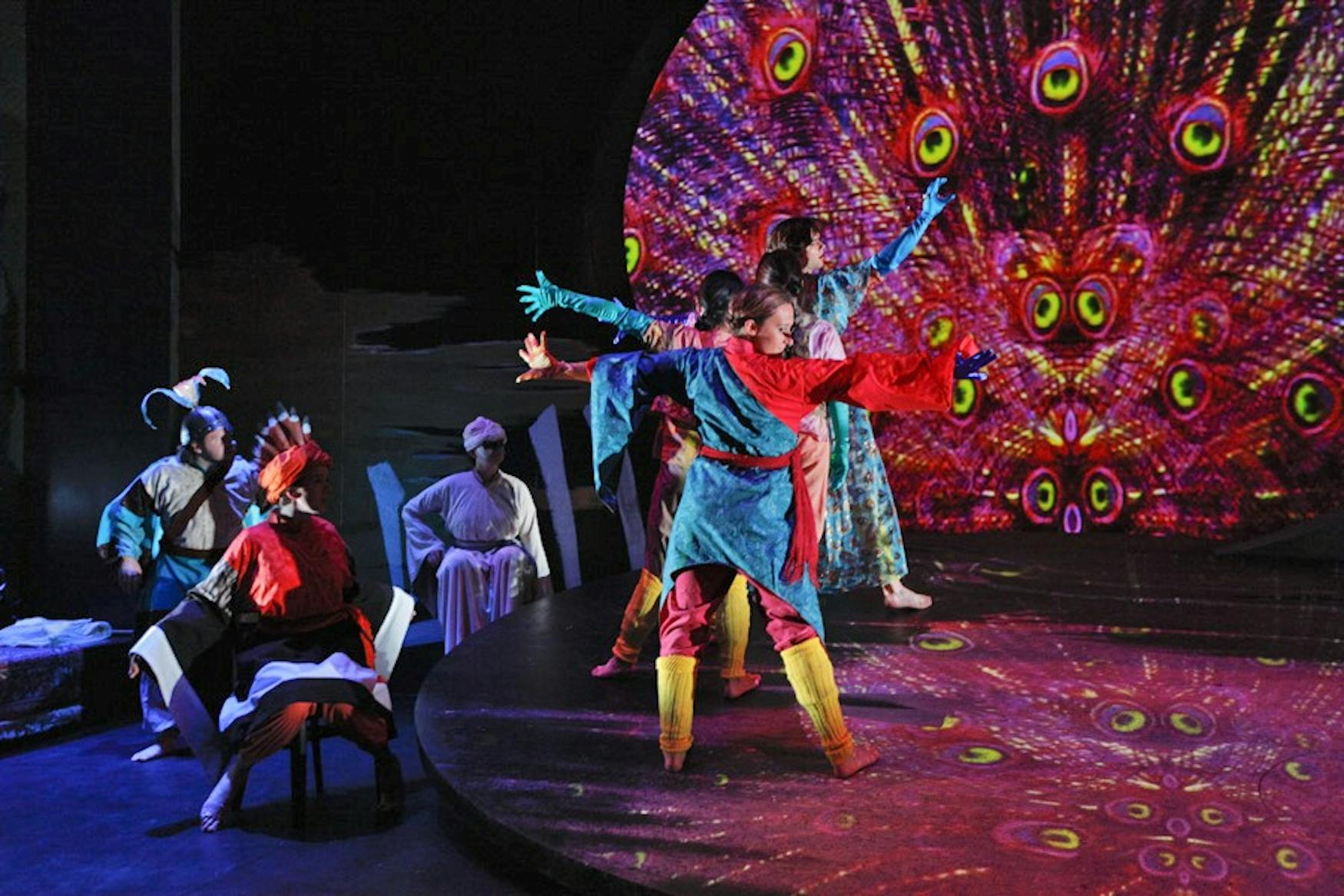BTC play brings epic Persian poem to life
This semester’s director-in-residence, Hafiz Karmali, worked with Brandeis undergraduate students on his version of Jean-Claude Carriere and Peter Brook’s production of The Conference of the Birds. From the various elements incorporated into the production, Karmali demonstrated an impeccable sense of space and actor and audience connection. The performance’s creative set included levels and dimension and musical interpretations that captures the audience’s emotions.
Karmali presented the story of the Hoopoe bird and her arduous journey in search of Simorgh, (which means thirty birds in Persian) to be their king. The story was part of Karmali’s continued attempts to free audiences from misconceptions about Islamic culture, and especially religion.
The Hoopoe bird, played by Samantha Levangie ’15, urges her fellow birds to embark on a journey across a long desert, over Mount Kaf—a threshold between life and death in Persian mythology—and past the seven valleys (Quest, Love, Understanding, Annihilation, Unity, Amazement and Death). After a thrilling expedition, the Hoopoe bird and 29 other birds arrive at the court to discover the profound secret of the king: “together as one entity, they form the divine King whose essence has always been present within them.”
Before the show even started, the Laurie Theater was filled with the sound of a tambur, a Turkish instrument that resembled a banjo with a longer neck. Suddenly, at the inception of the play, the audience is introduced to a silhouette of an actor dressed in a long skirt performing the Sama—a dance that entails whirling as a form of praise toward God. Men wear long white skirts while raising their right hand, in a cupped shape, up toward the sun and their left hand down towards the earth. The dancers tilt their heads down as if looking at their hearts. In maintaining this position while spinning in circles towards the left, the dancers are demonstrating the energy of the sun and the earth meeting in their hearts. Sama is translated throughout the production when the birds showcase travel and unity.
Karmali included a balanced and smooth transition between Turkish folk music and modern pop music. This allowed audience members to connect with the fusion of a culture they might not fully understand and the mainstream American culture. The scene of the peacock dance, where the birds encounter a beautiful peacock attempting to attract females through his dance, is a great example of Karmali’s attempt to bring the audience closer to the production. Ryan Millis ’15 (Waiting Woman/Peacock/Penguin/Man in Search) performed a hysterical dance as the vain peacock to “Booty” sung by Jennifer Lopez and Iggy Azalea.
The balance between both genres of music gave an eclectic feel to the production, which I would claim as an unusual experience. Because Karmali did not use Islamic songs exclusively, the audience was able to relate to the play without having to observe from a distance.
Black box theaters are limited in space and are known for their small, intimate atmospheres. Because the play was in such a space, I feared the actors would be limited and become repetitive in their travel patterns. Karmali overcame this challenge by creating a set with depth and levels, which was inspired by the Taziyeh form of theater. From last week’s presentation on Islamic performing arts, Karmali stated this style of performance re-enacts the death of a religious leader. Because Taziyeh uses a round stage in the center, many actors ran around the platform to show the act of traveling long distances.
Karmali placed a large wall with a circle cut out in the center right in front of the wings, the area on the side of the stage where there would normally be curtains. In front of this wall was a slanted, round platform that resembled the hole in the wall. When the actors in The Conference of the Birds demonstrated acts of traveling, they oftentimes circled the stage like the actors that perform in Taziyeh. This was an inventive and intelligent way to create more space because the actors were able to change their path every time they walked on and off stage.
During a lecture that Karmali gave last week about the play, he expressed his belief of “one sun and many rays,” which is what I think he was trying to communicate throughout the entire production. The birds flew together, regardless of their strengths and weaknesses, to accomplish one goal. It was the unity of the birds that made their journey through the desert and the seven valleys a possibility and success. Karmali’s interpretation of the production was phenomenal.
Despite the actors’ existing talents, Karmali made sure he showcased everyone’s special skill. The Parrot/Princess #1 (Samantha Lancey ’16) displayed her peculiar yet exciting parrot voice while the Exotic Bird/ Hermit (Miriam Goldman ’14) and the Nightingale (Rebecca Myers ’18) used their mesmerizing voices to sing opera-styled pieces including “Ave Maria.” Many of the other actors enhanced the show through their wit and commitment to their characters.
I thoroughly enjoyed the various elements Karmali and all the actors brought to this play, and I look forward to his future projects.



Please note All comments are eligible for publication in The Justice.